|
|
Ancient didactylism socks ...
[backcolor=transparent !important]When I came across this photo of a pair of very, very old socks, equipped with a concise signature "ancientaliens", I thought it was just another fake, which for some reason are very prone lately some iskussniki - often can not tell what is true. But it turned out that the original socks and tied somewhere 250 years BC in Egypt.

These Egyptian socks were found in ancient burial ground near Oxyrhynchus, on the site of a Greek colony on the Nile in central Egypt in the late 19th century. They were transferred to the Victoria and Albert Museum in 1900. Robert Taylor Esq. He was the executor of the estate of the late Major General Myers has considerable Egyptian collection, and these subjects were selected among many other textiles from the list as "very useful example."
In this case, "very useful example" is treated as a sample of museum workers labor-intensive single-needle knitting «nålbindning», which is used when it is necessary to achieve the elastic binding, in order to complete processing by a.
The original character of the foot support these socks, its elongation, and perhaps considerable size, fewer fingers than other people not taken into account. In Africa still live tribes whose foot is more like an ostrich than human. Sometimes there are other abnormalities that are atavistic or syndromic character. Perhaps the ancient racial diversity was much wider than it is now.
Socks surprised by the fact that they were connected in two thousand years before they became popular in Europe, that breaks stereotypes of civilization. As soon as they were found in a burial ground - an offering of the dead, that they could use them in another life. But there is no doubt that they were worn and live. Not all, of course.
|
|
|
|
|
|
|
|
|
|
|
|
|
skang pun ade stokin firaun nie.. |
|
|
|
|
|
|
|
|
|
|
|
seram je nengokk  |
|
|
|
|
|
|
|
|
|
|
|
|
Tak mcm stoking pun.. tak tau macam apa lah~ |
|
|
|
|
|
|
|
|
|
|
|
|
Hummm dua jari je ada kecacatan ke hapa |
|
|
|
|
|
|
|
|
|
|
|

Roman era sock for the left foot of a child with separation between the big toe and four other toes worked in 6 or 7 colours of wool yarn in a single needle looping technique sometimes called needle-binding and worked from the toe upwards. British Museum

Englishmen are notorious for wearing socks with sandals in summer. So, it seems, were Egyptians, if these c. 300 AD socks found in a tomb outside Oxyrhynchus are anything to go by. One major difference - the ancients went for bifurcate socks to accomodate the thong ... And some rather less conservative colours! I can just imagine Antony traipsing around Alexandria in a pair, although he probably would have chosen Imperial purple?
4th Century Egyptian Socksat 8/04/2011 10:51:00 AM
On my most recent trip to London, I visited UCL's Petrie Museum of Egyptology. I always keep an eye out for fiber and textiles artifacts when I'm in a museum, but I wasn't expecting to see much. Instead, I was just enjoying the mind-bogglingly extensive collection of ancient Egyptian relics. Until...
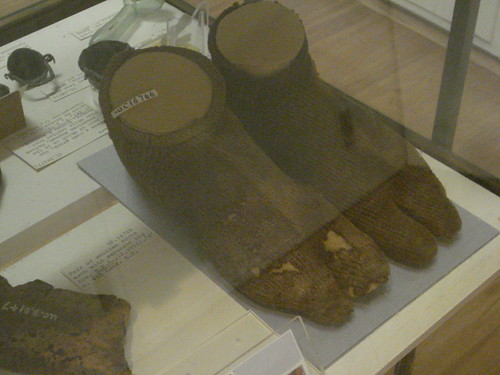
I was moving towards a new display case. First, I saw the spindles. Then, my eyes drifted to the right, and there they were: A pair of socks, in beautiful condition. Sure, there were a couple holes, but these socks are 1700 years old, and they're in better shape than some of my own knitted socks!
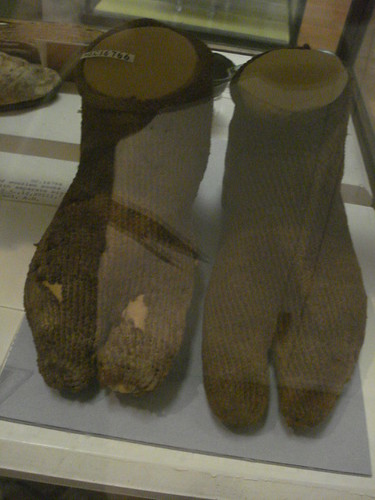
Interestingly, these socks feature a split toe - like 'tabi socks' or sandal socks. They're fairly short and have a rolled hem.
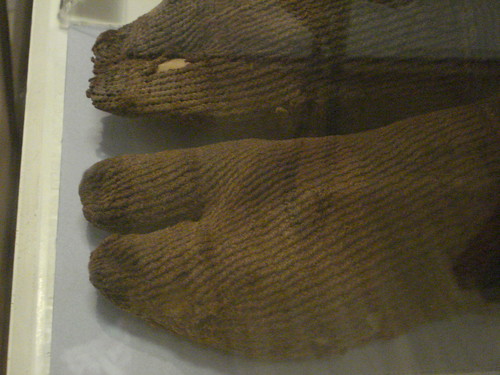
If you look at the stitches, you will see the distinctive 'v's that may remind you of knit fabric. In fact, if you knit a pair of socks, and twisted every stitch, the result would probably look very similar. However, these socks aren't knit -- instead, they were fashioned using an older technique that involves a blunt needle and short lengths of yarn -- nalbinding.
Nalbinding is a Scandanavian term, which simply means 'needle binding'. It is also referred to as 'knotless netting' or 'single needle knitting', though it is not technically knitting. In knitting, loops pass through loops, while in nalbinding, thread passes through the loops. This means that nalbinding doesn't unravel the way that knitting does. You can have a look at theconstruction of some nalbound stitches here.
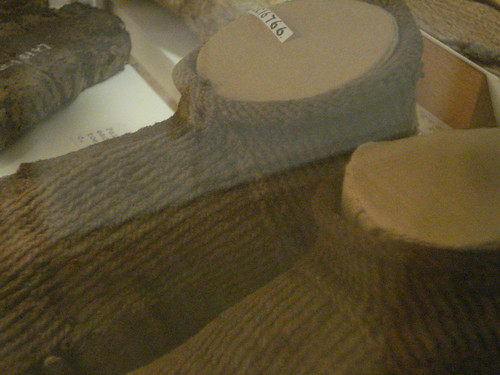
While researching the Petrie socks, I came across (actually, was alerted via Twitter about) afabulous blog written by some ladies who set out to recreate the socks! The blog includes several patterns, tutorials on the Egyptian method of nalbinding, yarn construction, other fiber artifacts at the museum and other extant examples of nalbound Egyptian Coptic socks.
See all my Egyptian textiles photos on Flickr.
There is now an article about these socks in the November/December '11 issue of Piecework.
~Joyuna
Child’s sock [Object][size=0.95em]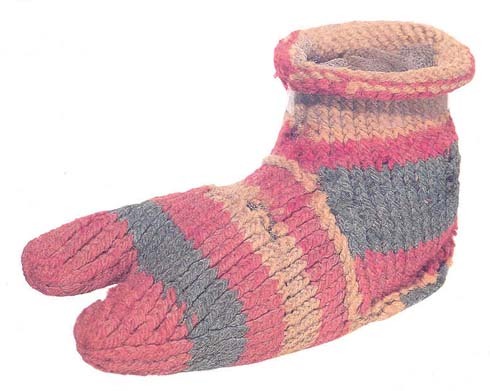
[size=0.95em]
Annotation[size=1.2em]Archaeologist W. M. Flinders Petrie found this child's sock, dated to the 2nd century C.E., in a cemetery at Oxyrhyncus, a Greek monastic centre on the banks of the Nile in Egypt. The sock is made of wool yarn in a technique called "sprang," or loop knitting, in which short pieces of yarn were looped in a circular pattern using a needle. The sock features a separate section for the large toe and was likely worn with a thong sandal made of woven rushes with leather strap and sole. This example is unusual both for the skill of its Egyptian maker and the elaborate multi-colored, striped pattern. It is rare for such common objects to be preserved in the archaeological record because they were subject to wear in life and disintegration after burial. Egypt's dry climate and the care taken with burials have preserved them. The technique of loop knitting was widespread in the ancient world, and has been identified in well-preserved textile examples from Peru, Denmark, and Greece. The technique sometimes involved use of a frame, and was used to make hairnets, hoods, and fishnets as well. Source[size=1.2em]Manchester Museum, University of Manchester, UK. Photo by Geoff Thompson. Cited in Harris, Jennifer, ed. Textiles: 5,000 Years. London and New York: Trustees of the British Museum/Harry N. Abrams, 1993. Loop knitting diagram by Dorothy Burnham, illustration (page 16) from Information Pack on Textiles in the Petrie Museum of Egyptian Archaeology at [size=0.95em]http://www.petrie.ucl.ac.uk/index2.html. How to Cite This Source
|
|
|
|
|
|
|
|
|
|
|
|
Ada jugak "jari" kat stokin zaman silam.
Stokin moden langsung tak ada jari ................betul2 cacat rupa. |
|
|
|
|
|
|
|
|
|
|
|
mmg pelik jawabnya ... |
|
|
|
|
|
|
|
|
|
|
|
ibu jari diorang besar kot...  |
|
|
|
|
|
|
|
|
|
|
|
|
aah pelik.. knp ade 2je kaki nyer... |
|
|
|
|
|
|
|
|
|
|
|
adakah firaun dulu makhluk asing yg membawa teknologi dlm pembinaan pyramid...
|
|
|
|
|
|
|
|
|
|
| |
|